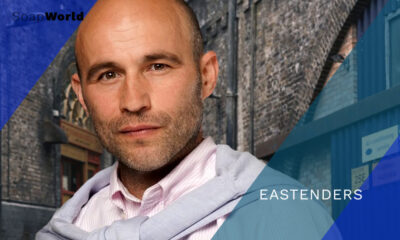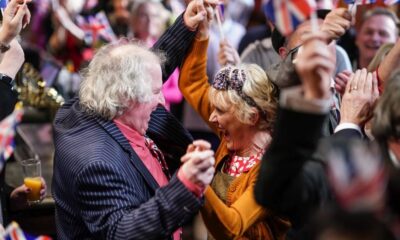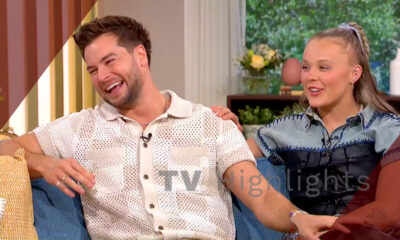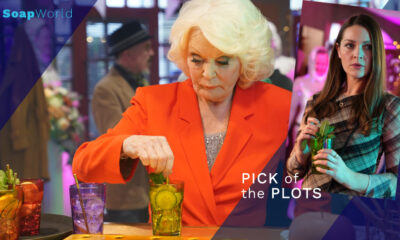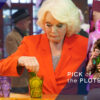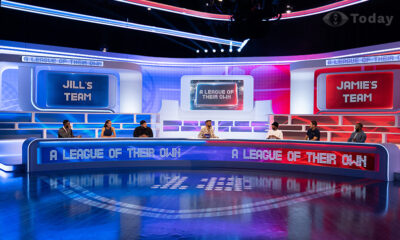Through the Years of ITV Breakfast – From ATV to GMTV
ATV Today takes a look back through British breakfast television as ITV reveal plans to ditch GMTV from the schedules.

Penny Smith and John Stapleton hosted GMTV’s Newshour
With the news that GMTV has been axed after 17 years, we take a look back at the rise and fall of morning broadcasting on the network. From the soapy mornings of the 1950s to regional ITV slots in the 1970s and the fall and rise of TV-am in the 1980s
When ATV and Associated Rediffusion hit the air in London back in September 1955 the hours in which the companies broadcast were limited. The stations went to air at 10.30am, signed off at around 1pm before returning for evening broadcasting at 5pm through until around midnight.
It seems ITV viewers, back then, were not entirely taken with morning broadcasting – after only a few months low ratings and poor revenue from the early schedules – featuring a mini-daily serial, ad-mags and music programming – were dropped.
The early schedule did, as we’ve said, provide the UK with its first daily drama series, the 10-minute short-feature, Sixpenny Corner. Created and written by, future Crossroads co-creator, Hazel Adair for Associated Rediffusion the show starred Howard Pays and Patricia Dainton in the lead roles of Bill and Sally Norton.
The drama revolved around the newlyweds and their struggles at running a dilapidated garage in the town of Springwood. The show aired at 11am until January ’56 then the rest of its episodes were broadcast in the evening, at just after 7pm, until its final screening in July 1956.
It wasn’t a great start to morning broadcasting for commercial television. For the best part of twenty years the ‘am’ schedules were left to educational broadcasting for school programmes and the occasional transmitter test announcements.

Bob Warman introduced viewers to Good Morning Calendar in 1977. Bob is best known for hosting ATV Today and Central News on ITV.
However in March of 1977 it was ATV face Bob Warman [pictured, below, right] who made broadcasting history as British television’s first breakfast time presenter. Warman had defected from evening news show ATV Today in the Midlands to Yorkshire Television’s version, Calendar, in 1976.
Good Morning Calendar, airing from 8.30am for 15 minutes was a regional venture into breakfast television, which proved to be mildly successful for the station over its six-week run. Tyne Tees Television also aired a similar experiment with Good Morning North. The rest of the ITV network, at this time, continued to start regular programming at noon.
Following these trial runs, the television regulator, the IBA, announced in 1979 there would be a new franchise for the commercial television licences on ITV. They agreed to, following much viewer consultation that, a breakfast station should air on the network, with a summer 1983 launch suggested.
ATV Network Limited, in 1980, planned a proposal for the morning slot under the brand of Daybreak Television. The operation, if successful, would have operated from the Elstree Neptune Studios – now home to the BBC and EastEnders – in North London.
There were also plenty of other companies scrambling to hold the first ITV breakfast franchise, including AM Television, ITN and Good Morning Television.

TV-am faces: Nick Owen, Wincey Willis, John Stapleton, Lizzie Webb and Anne Diamond.
However the franchise was awarded in December 1980 to a group known as ‘The Famous Five’ with their bid to launch TV-am. Lead by the man who in 1968 helped found London Weekend Television, Sir David Frost, TV-am was also, like LWT previously, aiming to be a highbrow alternative to the populist ITV schedules. The other key players were Michael Parkinson, Anna Ford, Angela Rippon and Robert Kee, all well-established broadcasters.
The IBA longed for ITV to be seen as more than just the home of entertainment (in their view gutter shows), and it seems, TV-am’s promise of a “mission to explain” appealed to the well-to-do of the regulator.
In February 1983 TV-am started their early morning transmissions [pictured right, Frost and Ford on day one], however the BBC have never liked to be second – thus they attempted to sabotage ITV’s breakfast triumph by rushing in a BBC News produced morning service of their own. To the amazement of viewers, the IBA and TV-am, Breakfast Time wasn’t a hard-edged news show as expected, but everything TV-am had hoped to be.The beeb version hitting the air two weeks before its commercial rival. TV-am proved to be a major failure for ITV. With the BBC leading in the ratings, advertising slots proved difficult to fill, and the commercials that did air failed to make the company much money due to low ratings.
The “mission to explain” was ditched and replaced with the “mission to stay on air”. Behind the scenes changes in management saw Anna Ford and Angela Rippon removed from the company. And just like LWT before it, the highbrow output was soon pushed aside to be replaced with, the much-loved by ITV viewers, populist formats.
A mix of serious reports and interviews sat easily alongside keep fit routines, cookery and entertainment features. Former ATV faces Chris Tarrant, Anne Diamond and Nick Owen proved a hit with viewers and the ‘stuffy, stilted’ TV-am bit the dust.

Anne Diamond and Nick Owen, former ATV presenters joined TV-am and boosted ratings.
TV-am, criticised for its low budget, invested more in its news programming – they had been shown up as being totally un-prepared for a major incident when the IRA bombed a hotel in Brighton. They even saw off the dreaded, and often ridiculous demands of, television unions. Unlike so many broadcasters of the time, TV-am refused to give in to unions – and when staff walked out, they were sacked. The company’s stance clearly pleased viewers, who had become tired of the union games – which often saw disruption in viewing their favourite shows.
TV-am seemingly could do no wrong by the late 1980s, its flagship magazine slot Good Morning Britain enjoyed healthy viewing figures, it had a popular line-up of presenters; including Lorraine Kelly, Mike Morris, Lizzie Webb and Rusty Lee and a successful news service. TV-am had gone from nearly bankrupt to the worlds most profitable television broadcaster. In 1987 ITV daytime expanded, with the schools programming moving over to Channel 4. The slots from 9.25am to noon were filled with various daily gameshows, a topical debate show, The Time, The Place, and in 1988 This Morning – which was very much to the format of TV-am’s Good Morning Britain.
The final success for the company saw TV-am overtake BBC One’s Breakfast Time in the ratings. Ultimately the corporation replaced the programme with a more serious news show.
It, therefore, came as a huge surprise when TV-am lost out to Sunrise Television in the battle to win the breakfast licence to broadcast on ITV beyond 1993. The regulator baffled viewers in their decision. Even the then Prime Minster, Margaret Thatcher, expressed her sadness and surprise that TV-am were losing their ITV licence.
Sunrise became GMTV, after Sky Television kicked up a fuss claiming they owned the Sunrise brand, and launched on January 1st 1993. Presenters Fiona Armstrong, Anne Davies, Michael Wilson and Eamonn Holmes gave viewers a taste of what was to come, and the viewer’s declared they preferred TV-am and promptly switched off.

TV-am’s Lorraine Kelly joined BBC Open Air’s Eamonn Holmes on GMTV.
GMTV had decided to re-invent mainstream breakfast television, with a bright modern new look, a more trendy slant to its features and a more upmarket focus. Presenters including Carol Voderman and Linda Lusardi failed to interest ITV viewers and after three months of declining ratings drastic action was taken. Channel 4 had the year previous launched The Big Breakfast which was aimed very much towards a youthful audience, GMTV needed to win over the Good Morning Britain audience..
In April 1993 GMTV re-launched, as a clone of TV-am. The cosier, homely set – clearly influenced by TV-am’s – was introduced. Some launch presenters bid farewell, including Fiona Armstrong, and Lorraine Kelly’s role was increased.
The TV-am styled GMTV proved to be a success, and remained so for over a decade. Presenters came and went – including Anthea Turner and Fiona Phillips – but the format remained practically the same. Quite out of the blue the cosy “we’re your friends” image was ruined in 2006 when phone-in scams, stretching back as far as 2003, were exposed.
The breakfast station was fined two-million pounds for ‘misconduct’ by the television regulator who described the incident as a widespread and systematic deception of millions of viewers. Some telly debaters believe the GMTV brand became damaged goods after this incident, and the company has found it difficult to shake-off its reputation. Former shareholder Disney was quiet throughout the whole debacle, but swiftly rid themselves of association to the tainted brand when they sold their shares off to ITV earlier this year.
On-screen, since the revelations of deceit, the brand was re-invented in 2008 with an entirely new logo [pictured below, right], tweaked format and Sky News’ Emma Crosby parachuted in to add depth to the line-up of frothy presenters. These changes proved to be of little use in stemming the decreasing viewing figures for GMTV. BBC One has dominated the breakfast ratings for a considerable length of time, which clearly has resulted in ITV bosses re-thinking their early morning schedules.

GMTV departures; Andrew Castle, Emma Crosby, Kate Garraway and Ben Sheperd.
In 2010 a string of announcements revealed serious changes for GMTV; firstly a number of the company’s popular faces including Penny Smith, Ben Shephard and Andrew Castle were to leave. Former BBC One personality Adrian Chiles was to take a key presenting role at the company and in June the biggest change of all – the axing of the GMTV brand.
Names suggested include, ITV Breakfast, ITV Daily, Daytime, Good Morning Britain and Daybreak. The latter would take us right back to 1979 and ATV’s submission…
ITV will reveal their new look replacement for GMTV in September 2010
Do You Remember..?
Daybreak – the short lived name of TV-am’s early morning news show.
The revolving weather map – a rectangle shaped hole in the wall, which had a rotating box with a map of the UK stuck on each side. When rotated it would show different times and days. The stick-on clouds and sunshine often dropped off.
Wincey Willis – ruler of the dodgy weathermap, who tried her best to keep the clouds on the map rather than the floor.
Anne Diamond and Nick Owen reading out the winning bingo numbers from the tabloids.
Top Of The Morning – GMTV’s version of After Nine, which was culled in the April 1993 revamp.
Russell Grant – with his mystic predictions and iffy jumpers.
Mad Lizzie and Mr Motorvator – the keep fit experts.
Rusty Lee’s legendary cookery spots, which always included a roaring laugh from the chef.
News provided by Gordon Honeycombe
The Egg-Cup logo at the end of each edition of TV-am.

Gordon Honeycombe, from ITN to TV-am for a serious news style.

